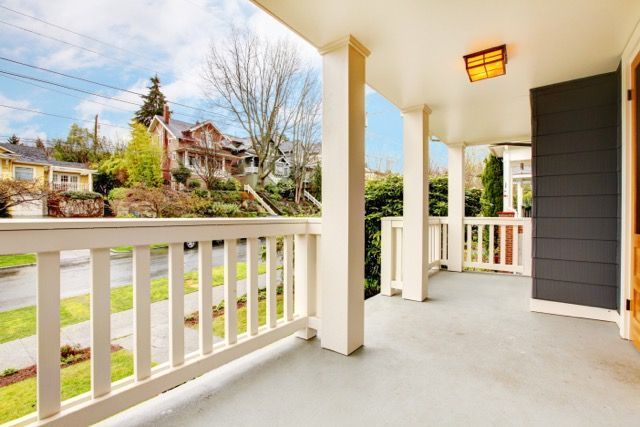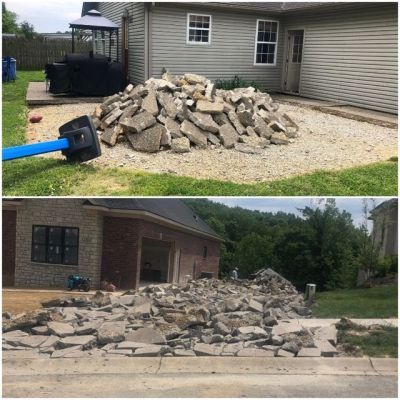Pros & Cons of Concrete Leveling vs. Concrete Replacement
August 19th, 2022 | 6 min. read
By Sarah Etler

Thinking about fixing your damaged or settling concrete? Check out the advantages and disadvantages of concrete replacement and concrete leveling to decide which is best for you.
The concrete on your property is a big investment, so you want to make sure that it’s taken care of and protected. But what happens when regular maintenance can’t keep up with natural factors like erosion, settling, or crumbling?
You have many options for professional concrete repair, but the biggest contenders are concrete leveling, which lifts the existing concrete slab back to its original position, and concrete replacement, which tears out the existing concrete slab and pours it new.
This guide will walk you through the advantages and disadvantages of both concrete leveling and concrete replacement so that you have all the facts you need to choose the best concrete repair method for your situation.
Should you replace your concrete?
Replacing concrete is no small task, but sometimes it’s the best option depending on desired results. This section will cover the advantages and disadvantages of replacing your concrete.
| Advantages | Disadvantages |
|---|---|
|
|
|
|
|
|
|
|
|
|
|
|
|
Advantages of Replacing Concrete
Here are some of the pros to tearing out old concrete and pouring it fresh:
-
New concrete is a clean slate
When concrete is poured, it looks fresh. Having everything look uniform, clean, and pristine is a nice feeling, especially when you’re replacing all the slabs in an area and not just the problem ones.
Also, getting new concrete gives you a fresh slate for taking care of it the way it should be, and maybe your old concrete wasn’t getting that attention from the get-go. New concrete can be sealed from the beginning, helping protect your investment from future damage.
-
No initial breaks
Because concrete is poured brand new, it usually doesn’t come with the cracks or breaks that existing concrete can have from years of freezing and thawing. Another benefit that goes along with this is that when cracks do appear, you can get them caulked quickly and prevent further damage.
While this is true, new concrete is not a perfect solution and can still develop cracks quickly. Below is a photo of a newer slab of concrete with a large crack.

-
Customizable
Getting new concrete poured allows you to be more creative and get custom solutions. Unlike concrete leveling, if you didn’t like what you had before, you can customize it to get a solution that better fits your needs.
For example, if you wanted a ramp but originally had steps, you can get this changed with concrete replacement.
-
Can fix underlying issues
If you have a big underlying problem, generally concrete replacement will be your best bet at fixing it. Adding drains or rerouting pipes are things that are best left for concrete replacement projects, as these aren’t accessible when only lifting the concrete slabs.
-
Very predictable
Due to the nature of concrete replacement, not much is left up to chance. Because the existing concrete is torn out, there’s a blank canvas where almost everything can be seen and the outcome, like the slope and how water will drain, can be perfectly predicted.
Disadvantages of Replacing Concrete
Here are some of the cons to tearing out old concrete and pouring it fresh:
-
Expensive
Generally, concrete replacement is far more expensive than concrete leveling. Most of the time demolition and removal of the existing concrete have to be factored into the price, causing it to rise. Cost is a big deterrent for many people who are weighing concrete replacement.
Because concrete leveling is much faster and less invasive, it can cost up to 70% less than replacement.
-
Time-consuming
Concrete replacement is not a fast process. It typically takes 1-3 days to build a concrete driveway, 2 more for it to cure enough to be able to walk on it, and up to 28 days for concrete to cure enough to not risk piercing, chipping, or other damage.
-
Risky/unknown quality
Unfortunately with concrete replacement, you don’t actually know the quality of your concrete until you get it installed and wait for it to cure. You may rip out good-quality concrete and replace it with bad-quality concrete without knowing, and concrete replacement typically doesn’t come with a warranty.
It’s also important to hire a good concrete contractor, as not all concrete contractors are created equal. You can oftentimes find cheaper replacement options, but they are generally going to give you bad results.
-
Resettling
Because the ground around new concrete compacts and shifts under the weight of the concrete, typically slabs settle naturally within the first 5 years of installation. Once a slab has settled, the only way to recover it is by leveling it or replacing it again.
-
Slabs won’t match
While fresh new concrete looks very nice when all the concrete is replaced at the same time, when one or two patches are replaced and the rest is left behind, it can look mismatched. While for some this isn’t an issue, others will be bothered by the looks of their concrete.

-
Big equipment
Concrete replacement requires large, invasive tools to get the job done. Big concrete trucks and equipment can be a nuisance for property owners when they have to drive through yards and disturb landscaping, grass, and other delicate areas.
Should you level your concrete?
While not the perfect solution for every situation, concrete leveling may be the right option for you. This section will cover the advantages and disadvantages of leveling your concrete.
| Advantages | Disadvantages |
|---|---|
|
|
|
|
|
|
|
|
|
|
Advantages of Leveling Concrete
Here are some of the pros to lifting those existing concrete slabs:
-
Less messy
Concrete leveling is much cleaner than concrete replacement. The process requires no demolition, and the cleanup is as simple as spraying down the area with a hose to remove any extra material. Landscaping and plants stay intact and unharmed with a concrete leveling repair.
Below are photos of the mess that concrete replacement can make.

-
Faster
For a concrete leveling repair, the team is usually in and out in a matter of hours, and you can use your concrete the same day rather than waiting days for it to cure enough to even touch. You also save time by not having to rip out and clear away existing concrete with the demo process.
-
Cheaper
Because concrete leveling uses less material and takes less time overall, it can save you up to 70% of the cost of replacement. The top end of the A-1 Concrete Leveling price range is the typical bottom end of the replacement price range.
-
Smaller equipment
The equipment used to perform a concrete leveling repair is smaller and less invasive than big concrete replacement trucks and tools. You don’t have to worry about concrete leveling destroying your yard or making a mess of your landscaping, as the repair is easier to manage and keep contained.
-
Same quality concrete
When you get your original concrete leveled instead of replaced, there are no surprises with the quality of concrete you’re getting, because the concrete you already have will be what you keep. If you’re getting it replaced, there’s a possibility that you will be replacing good-quality concrete with bad.
Disadvantages of Leveling Concrete
Here are some of the cons to lifting those existing concrete slabs:
-
Can’t fully predict the outcome
If you’re working with a reputable and trustworthy concrete leveling team, they should be able to roll with any obstacles that come up and give you a great result, but it may not be the result you were initially expecting.
Sometimes even the best experts can’t fully predict what the outcome will be, but your concrete leveling company will be able to provide you with a few very likely results and make sure you’re okay with each of the possible outcomes.
-
Can’t slide concrete back into place
Concrete leveling can’t work against gravity, and when a slab is sliding down a hill or slope, there’s not much that leveling the slab will do. While in most cases it can be lifted back to a level position, a slab of concrete on a slope often can’t be slid back up again and to where it originally was and will have to be replaced.
-
Drill holes may not match
While not as obvious as mismatched concrete slabs, patched drill holes that don’t match the concrete can be a nuisance, especially in an area with decorative or patterned concrete. Having a skilled concrete leveling team can help, however, as there are lots of ways to blend the drill holes into the existing concrete.

-
Can’t get rid of existing cracks
Because the concrete actually isn’t being replaced or changed, only lifted, the existing cracks won’t go away completely. In fact, sometimes they can open up larger or get smaller depending on the circumstances of the repair.
This is not as big of a deal when you have experienced concrete leveling professionals handling your repair, as they will be able to caulk the cracks to help prevent further damage and minimize their appearance.
-
Concrete surface remains the same
Again, concrete leveling utilizes the existing slabs rather than making new ones, so the imperfections on the concrete’s surface won’t go away after being leveled. This is important for people who want a seamless finish, as concrete leveling won’t be able to provide that unless the existing slab was already seamless.
Below is a photo of surface damage that can’t be removed with concrete leveling.

So, which option is right for you?
Now that you’ve taken the time to get to know the advantages and disadvantages of both concrete replacement and concrete leveling, it’s time to decide which process is better suited for your concrete problems.
Even though we at A-1 Concrete Leveling know that concrete leveling is a great solution for many people, we recognize that there are pros and cons to both methods of concrete repair that may be better for your individual needs.
You can continue learning about concrete leveling with the resources available in our Learning Center, and if you’re interested in a free consultation and pricing estimate, click the link below to fill out a request form.
Click Here to Find Your Nearest Location and Receive a FREE Estimate
Sarah Etler joined A-1 Concrete Leveling after receiving her Bachelor of Arts degree in English from Northern Kentucky University. As A-1's Content Marketing Manager, she works closely with industry experts to produce content that will best answer questions related to concrete repair and maintenance practices. Sarah loves living a life full of discovery and is excited every day to see what new things she can learn and share with those around her.